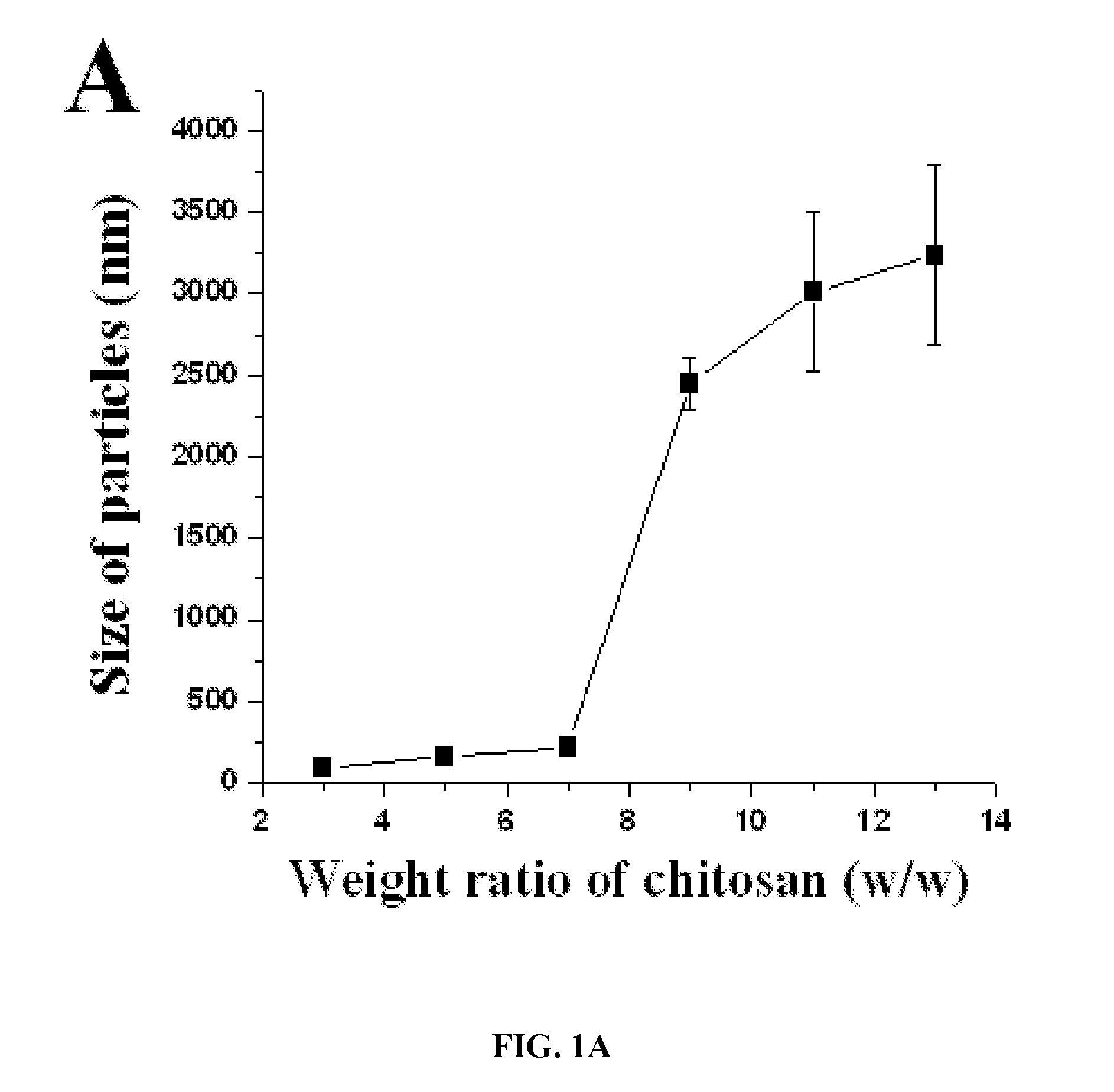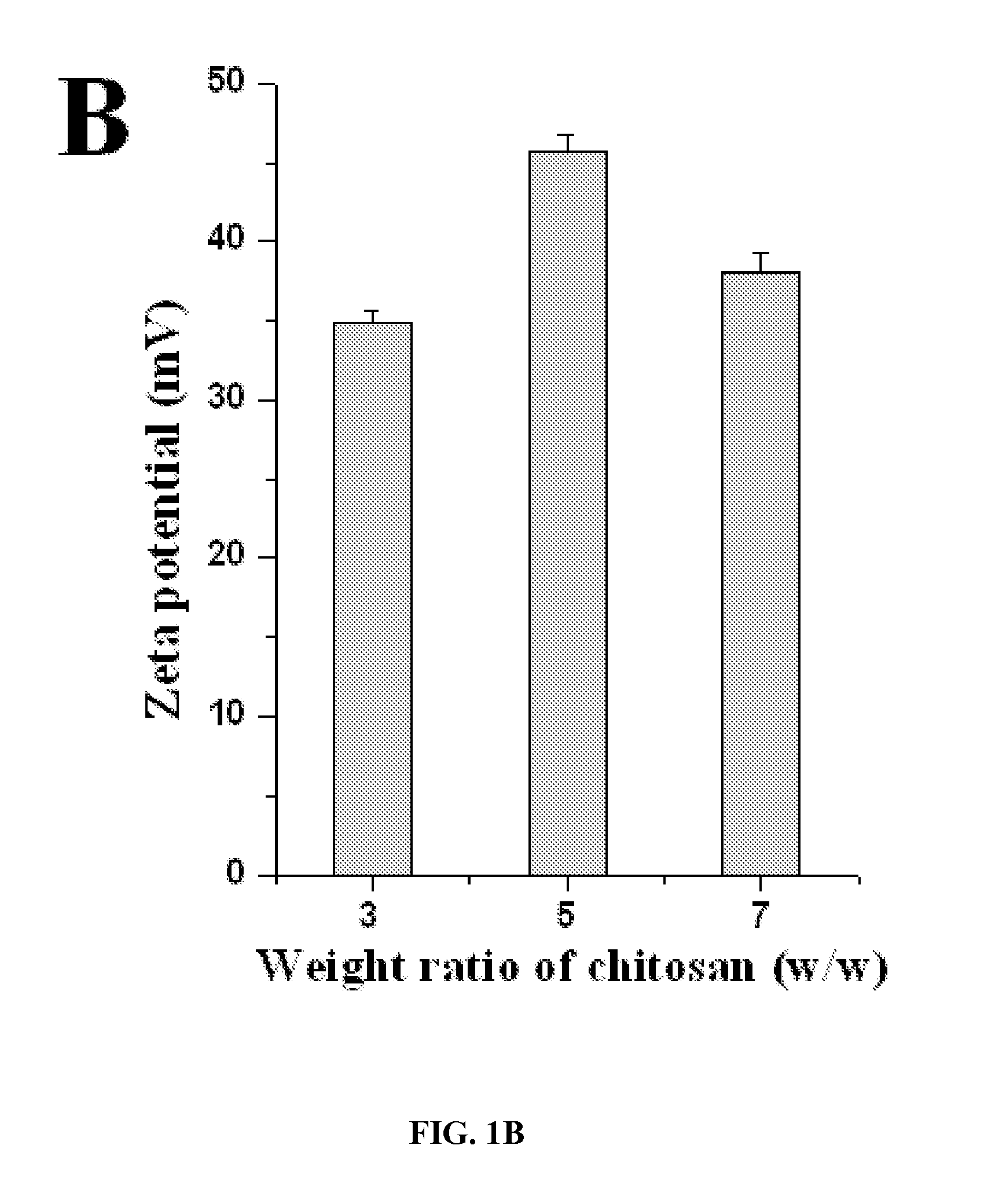Methods and compositions involving chitosan nanoparticles
- Summary
- Abstract
- Description
- Claims
- Application Information
AI Technical Summary
Benefits of technology
Problems solved by technology
Method used
Image
Examples
example 1
Method for Preparation of Nanoparticles for the Delivery of siRNA
[0219]Chitosan nanoparticles were prepared according to the procedure based on the ionic gelation of chitosan with tripolyphosphate anions. The formation of the particles was a result of the interaction between the negatively charged groups of the tripolyphosphate and the positively charged amino groups of chitosan.
[0220]Chitosan with the deacetylation degree of 75-85% and the viscosity of 20-200 cP was dissolved at 0.5% (w / v) with 1% (v / v) acetic acid. The pH of the chitosan gel raised to 4.6 with 10 N NaOH. NaOH was added under magnetic stirring (high speed) drop by drop (each drop should be 4 pl) to raise pH. Chitosan nanoparticles formed spontaneously upon addition of aqueous tripolyphosphate solution to chitosan solution under magnetic stirring at 1200 rpm and mixed for further 10 minutes after addition of tripolyphosphate (Chitosan to TPP weight ratio is 6:1 and chitosan to TPP volume ratio is 3:1). The particles...
example 2
Method of Preparation of Nanoparticles for the Delivery of siRNA
[0222]The following is another example of a method for the preparation of chitosan particles. About 50 milligrams of Chitosan (Mw. 50000-190000, Sigma) was dissolved in 10 ml of 0.25% acetic acid solution. Chitosan solution was isolated by centrifugation to remove contaminants. The pH of this mixture was adjusted to 4.6 with 10 N NaOH. 0.25% TPP (tripolyphosphate) solution was prepared. 140 ul of TPP (0.35 mg) and 35 ug of siRNA were mixed. Chitosan solution was added to 175 μl of both TPP and siRNA solution. The mixture was incubated in ice (4° C.) for 1 hr. The mixture was purified by centrifugation at 12000 rpm for 40 min at 4° C. (three times). After purification, chitosan nanoparticles were obtained.
TABLE 1Formulation of siRNA-incorporated chitosan particlesWeight ratio (chitosan:TPP)Chitosan (mg)TPP (mg)1:10.350.353:11.050.355:11.750.357:12.450.359:13.150.3511:1 3.850.3513:1 4.550.3515:1 5.250.35Total volume: 700 ...
example 3
Role of the Spinal M2 Receptor Subtype in the Analgesic Effect of the Muscarinic Receptor Agonist
[0228]The muscarinic acetylcholine receptors (mAChRs) in the spinal cord are important for the regulation of pain transmission. There are three mAChR subtypes in the spinal dorsal horn: M2, M3, and M4. However, the relative contribution of each mAChR subtype in the spinal cord to pain modulation remains unclear. Because the specificity of the available agonists and antagonists for each mAChR subtype is limited for in vivo use, it will be difficult to assess the contribution of individual mAChR subtypes to the spinal muscarinic analgesia by using pharmacological approaches.
[0229]Compared with the antisense technique, which requires potentially toxic concentrations to achieve gene-specific suppression, the efficient and reproducible silencing effects of double-stranded siRNA make RNA interference highly advantageous. Efficient delivery of siRNA into the neural tissues in vivo, however, has...
PUM
| Property | Measurement | Unit |
|---|---|---|
| Fraction | aaaaa | aaaaa |
| Fraction | aaaaa | aaaaa |
| Viscosity | aaaaa | aaaaa |
Abstract
Description
Claims
Application Information
 Login to View More
Login to View More - R&D
- Intellectual Property
- Life Sciences
- Materials
- Tech Scout
- Unparalleled Data Quality
- Higher Quality Content
- 60% Fewer Hallucinations
Browse by: Latest US Patents, China's latest patents, Technical Efficacy Thesaurus, Application Domain, Technology Topic, Popular Technical Reports.
© 2025 PatSnap. All rights reserved.Legal|Privacy policy|Modern Slavery Act Transparency Statement|Sitemap|About US| Contact US: help@patsnap.com



